"Bush Eats Mexico's S**T". San Cristóbal, Chiapas, 2006. All photos by Mexico Cooks! unless otherwise noted.
Looking around–really observing the flow of life–in Mexico, it's easy to see that the times, they are a-changing. Whether you're watching the wall of a farmer's field or suddenly spying an all-but-hidden wall around an obscure corner in Mexico City, you become aware that art, both art-for-art's-sake and political art, is everywhere. These days, street art is sometimes hand-painted but more often than not, it's a stencil.
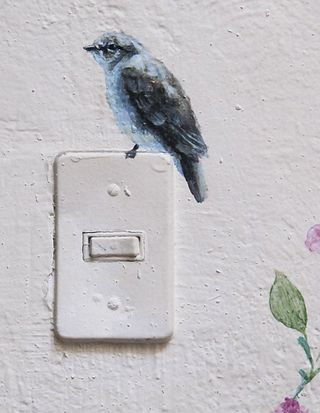
Delicately painted by hand, this peaceful, charmingly rendered bluebird (undoubtedly the bluebird of happiness) perches quietly on a light switch at Restaurante Rosetta. Mexico City, 2013.

The chapulín (grasshopper) is an icon not only of Oaxaca's gastronomy, but also of the state's cultural identity. It's about who we are, not simply what we eat. "Made in Oaxaca" is the slogan's translation. Oaxaca de Juárez, 2013.
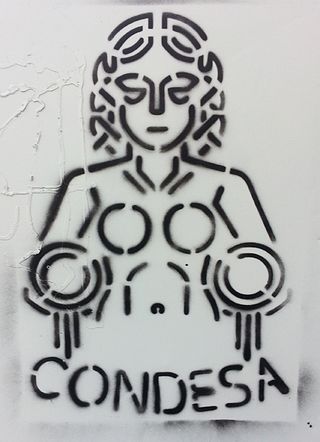
Another icon: in this case, art imitates art. José María Hernández Urbina's original Art Deco-era statue, Fuente de los Cántaros (Water Jars Fountain), still graces the Teatro al Aire Libre Lindbergh (Lindbergh Open Air Theatre) wall in Parque México, Colonia La Condesa. This stencilled grafito graces the same wall. Mexico City, November, 2013.
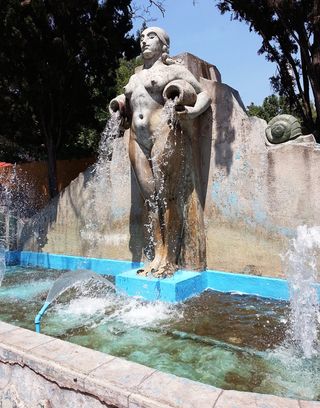
The actual fountain in Parque México. Photo courtesy Judith McKnight.
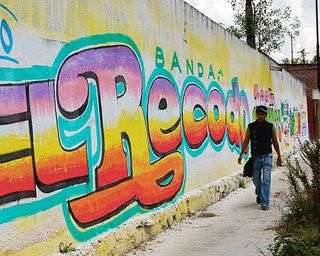
Advertising Banda El Recodo (one of Mexico's most popular), this wall and others of its genre are hand-painted calls to party hearty. These hand-painted advertisements are ubiquitous in every Mexican state, whether in huge cities or tiny villages. The highly skilled but minimally paid graphics artists paint these signs freehand. Photo courtesy theatlantic.com.

Mexico is a country of enormous and frequently surrealistic differences. The stereotypical meek and humble Mexican contrasts sharply with the equally stereotypical highly politicized and revolution-hungry Mexican; the polemic is often contained in the self-same individual's mind and body. These blood-red words read, "Mexico is no longer a country for cowards." Mexico City, April 2013.
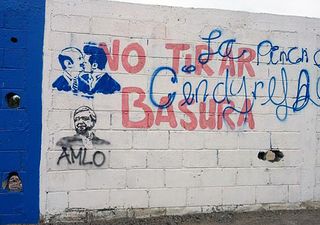
This wall in the State of Mexico originally held a no-nonsense civic-minded slogan: No Tirar Basura (Don't Throw Your Garbage Here). One or two waggish political commentators superimposed stencils of (top, blue) former Mexican president Carlos Salina de Gortari kissing 2012 presidential candidate Enrique Peña Nieto and (bottom, black) 2012 presidential candidate Andrés Manuel López Obrador. No Tirar Basura, indeed. Estado de México, 2012. Photo courtesy hazmeelchinagdofavor.com.
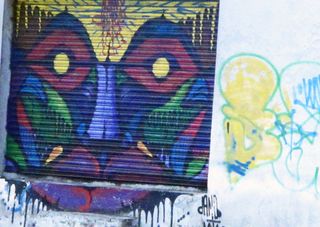
Garage door, Mexico City, March 2014.
Calls to political action are common representations in urban street art. At the end of 2013, Mexico's federal government voted to change the Constitution to allow some privatization of Mexico's petroleum industry. That change has been argued all along the political spectrum. Is it good for Mexico? Is it bad for Mexico? This stencilled poster falls into the 'bad for' column. The bureaucratic rats have parachuted onto our oil derricks, the police show up as granaderos (shield and truncheon-bearing 'crowd control' officers), and the poster calls for revolutionary action against so-called energy reform. Oaxaca de Juárez, January 2014.
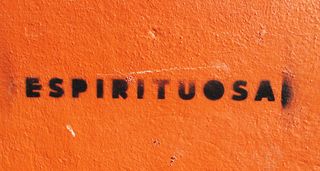
Spirited. Alive. That's Mexico's graffiti, summed up in a single word on a tangerine wall. Oaxaca de Juárez, January 2014.
Looking for a tailored-to-your-interests specialized tour in Mexico? Click here: Tours.
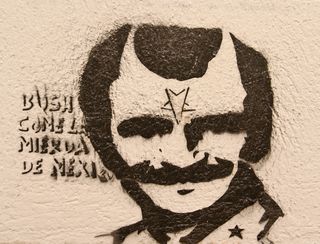
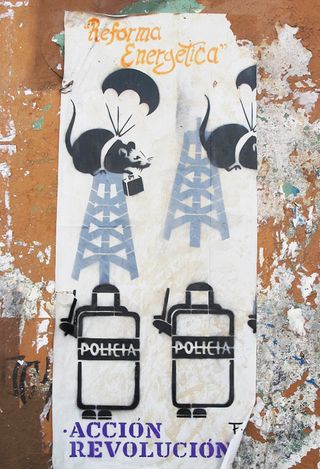
Leave a Reply